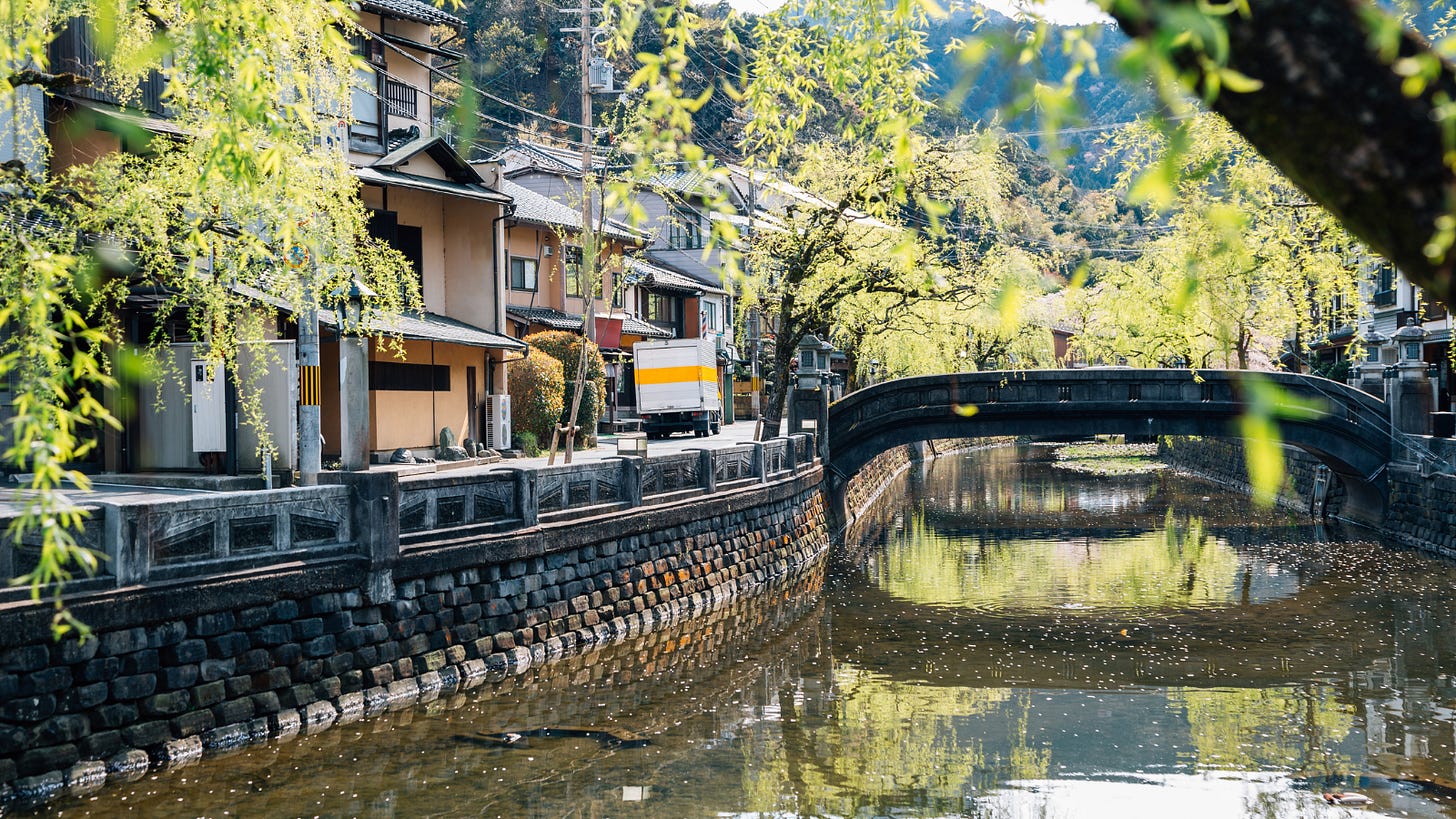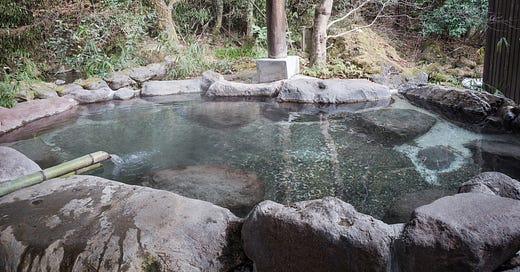Thermal springs for your aches & pains (Part 1)
I’m writing from a beautiful part of the Japanese countryside this week! In a two-part essay, I’ll share what I’ve learned about the healing waters of the famous Japanese onsen.

Hello from Japan! I’m here for a large international dermatology conference: The First International Societies for Investigative Dermatology Meeting (ISID 2023), which brings together a large international group of scientists and physicians working at the frontiers of skin health and biology. I came to Japan to learn a few days before the meeting to learn more about the healing waters found across the country.
Thermal waters of Japan
Japan is a hotbed of geothermal activity. An incredible 25,000 hot spring sources are spread across the country and at least 3,000 bathing facilities (onsen) use the naturally heated waters from these springs.
What is an onsen?
Onsen are the hot springs and bathing facilities that use these naturally heated mineral waters from the ground. Onsen are also popular spots for Ryokan (traditional Japanese inn) establishments. Locals and tourists alike visit the onsen for their healing properties. There are various types of onsen available: some are public baths that can be accessed with an entry fee, whereas others are private and can only be accessed when you stay at certain hotels or inns.
The Japanese Hot Springs Act defines onsen as hot water, mineral water, or water vapor gushing from underground, with specific temperature and mineral content requirements. Onsen water may contain various minerals or chemicals that are believed to provide health benefits. Different types of onsen water, such as sulfur onsen, sodium chloride onsen, hydrogen carbonate onsen, and iron onsen, are often displayed by establishments based on their distinctive mineral content.
Are there medical benefits to onsen?
A visit to an onsen (or a thermal spa in any part of the world) can be for simple enjoyment, but are there medical benefits as well? My skeletal deformities leave me in an unfortunate state of chronic neuromuscular pain. My right hip has developed advanced arthritis due to the number of reconstructive surgeries done on it in my childhood. When it comes to complementary therapies for muscular and bone pain, you could say I’m a bit of a connoisseur! This lifelong battle with pain motivated me to seek out an onsen experience while in Japan for work.
So, what does the scientific literature say? Unfortunately, not much! After searching under various keywords in medical databases, I found one new study (published in 2022) performed in Italy that gets close to an answer on the therapeutic benefits of thermal waters on musculoskeletal pain. This observational study evaluated the short-term effects of spa rehabilitation on pain, mood, and quality of life among patients with degenerative or post-surgery musculoskeletal disorders. They enrolled 160 patients from six Italian spa facilities, and 123 patients were assessed. All patients underwent 12 water-based exercise sessions for two weeks, with some also receiving traditional thermal therapies. Here’s the crux of what they found:
Evaluation before and after the treatment showed a significant improvement in all scores evaluated, with no significant difference between patients who received water-based exercise only or those who also received traditional thermal therapy.
After spa rehabilitation, patients with degenerative or post-surgery musculoskeletal disorders showed favorable effects on pain, mood, and quality of life.
The Takeaway
The study offers evidence that spa rehabilitation can be an appropriate alternative strategy for post-orthopedic surgical recovery. However, further research is needed to confirm these findings.
Kinosaki Onsen

I had the incredible opportunity to experience the famous Kinosaki Onsen village with friends this week. While my experience is not based on a clinical trial and is thus considered anecdotal, I did experience substantial relief in my back (muscle) pain and hip (osteoarthritic) following a two-day regime of thermal spring sessions, a deep tissue massage, and aromatherapy massage.
Was it the water, massages, or both that helped? Who knows? I wanted to achieve relief, and that’s what I got! I think anyone battling chronic pain would agree that, more often than not, it is not a simple therapeutic intervention that helps but rather a combination of interventions tailored to your individual body’s needs.
Of note, while most onsens prohibit entry to anyone with tattoos, Kinosaki Onsen is one of the few onsen villages where tattoos are permissible. Keep an eye out for my next post on Thursday, where I’ll break down what the experience of visiting the Seven Mystic Onsen was like and offer some great practical tips on how to visit this location or other onsen in Japan!
Yours in health, Dr. Quave
Cassandra L. Quave, Ph.D. is a scientist, author, speaker, podcast host, wife, mother, explorer, and professor at Emory University School of Medicine. She teaches college courses and leads a group of research scientists studying medicinal plants to find new life-saving drugs from nature. She hosts the Foodie Pharmacology podcast and writes the Nature’s Pharmacy newsletter to share the science behind natural medicines. To support her effort, consider a paid or founding subscription, with founding members receiving an autographed 1st edition hardcover copy of her book, The Plant Hunter.





I'm so pleased you are finding some pain relief. Hoping you might replicate the experience at home. I love following your posts!